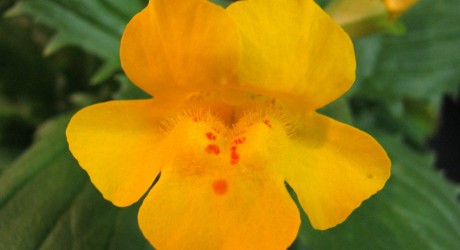A SCIENTIST at the University of Stirling has discovered a new species of plant on the bank of a Scottish stream, which has evolved extraordinarily as the result of overcoming infertility.
The discovery of the new monkey flower by Stirling’s Dr Mario Vallejo-Marin, whose research has been published in the open access journal, PhytoKeys, represents a rare example of a species being found to have originated in the wild within the last 150 years. Whilst thousands of other wild species and crops are thought to have originated in similar ways, including wheat, cotton and tobacco, only a mere handful of examples exists in recent history.
Dr Vallejo-Marin, a plant evolutionary biologist within the School of Natural Sciences, said: “Our discovery will help enable scientists to understand how new species form. Finding examples of the process in action is rare, so this is an exciting opportunity to study evolution as it happens.”
The new yellow flower is derived from the union of two New World species, originally brought to the UK in the 1800s as botanical curiosities and featured in Victorian gardens. Soon after their arrival, the parent plants escaped garden confines and began to grow in the wild along the banks of rivers and streams. Reproduction between these parents then produced hybrids which are now widespread in Britain.
Normally, genetic differences between two species render hybrid offspring infertile and unable to go beyond the first generation but, surprisingly, Dr Vallejo-Marin found wild hybrid plants that have overcome these genetic barriers to possess fully restored fertility. The fertile hybrid therefore represents a completely new species, native to Scotland.
The researcher has chosen to call the species Mimulus peregrinus, which translates as ‘the foreigner’ or ‘the traveller’, to reflect the wandering origins of the new native British plant – the parents of which were both foreigners introduced from the Americas.
Dr Vallejo-Marin explained that the normal failure of separate plant species to reproduce and create fertile hybrid offspring is due to differences in the amount of DNA present in each species. “It’s the equivalent of crossing a horse and donkey and getting a sterile mule,” he said.
“However, in rare cases, duplication of the entire hybrid DNA – known as polyploidisation – can balance the amount of DNA and restore fertility. Our studies suggest that this is what has happened here.”
He added: “We do not yet know how common the new species is or how well it will fare, so the next step will be to find out its distribution and establish whether its ecological characteristics allow it to colonise environments that cannot be exploited currently by its parents.”
Ends
Further information from Dr Mario Vallejo-Marin on +44 (0) 1786 467822 or at mario.vallejo@stir.ac.uk
Notes to editors
Photo credit: Mario Vallejo-Marin
Image caption: Close-up of the new species of monkey flower, Mimulus peregrinus
MEDIA RELEASE posted by the University of Stirling. You too can post media releases on www.allmediascotland. For more information, email here. And do feel free to follow www.twitter.com/allEducationPR.
Contact: Dr Mario Vallejo-Marin
Phone: +44 (0) 1786 467822
Email: mario.vallejo@stir.ac.uk
Website: http://www.stir.ac.uk






